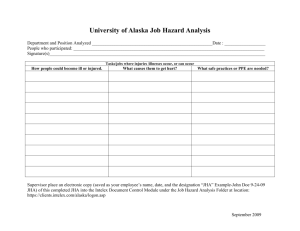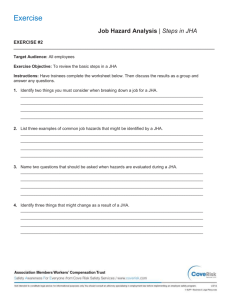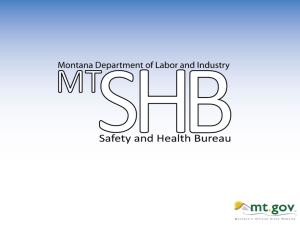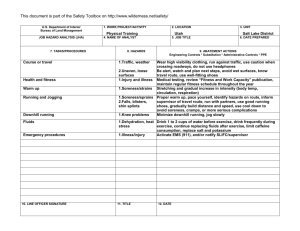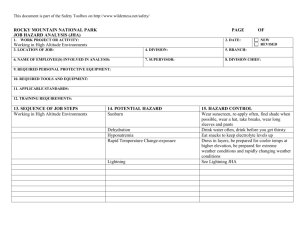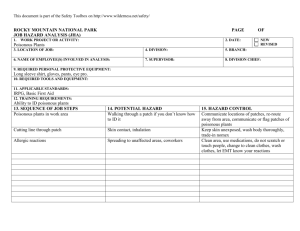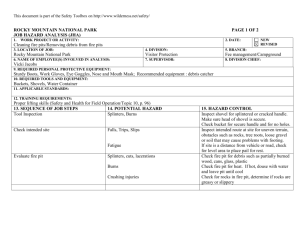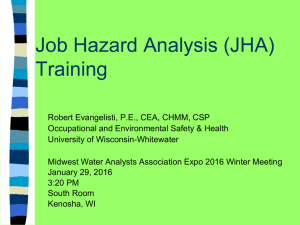rocky mountain national park page of
advertisement
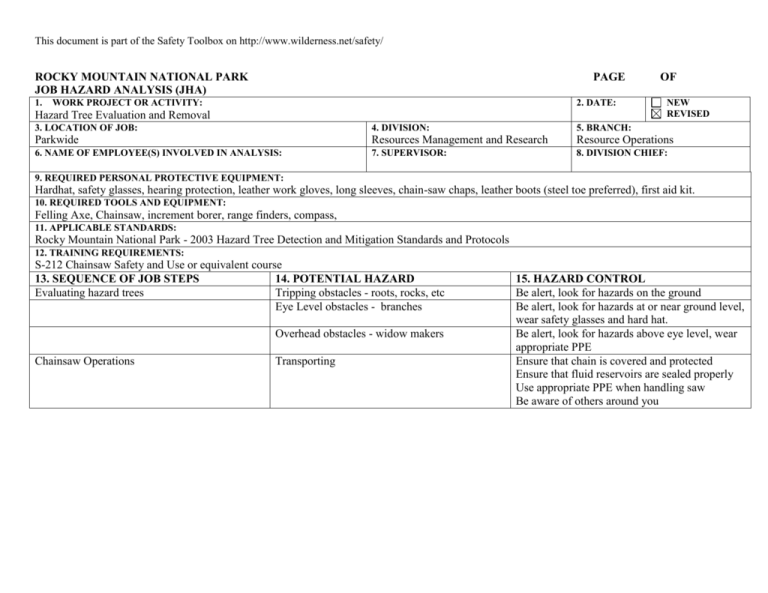
This document is part of the Safety Toolbox on http://www.wilderness.net/safety/ ROCKY MOUNTAIN NATIONAL PARK JOB HAZARD ANALYSIS (JHA) 1. PAGE WORK PROJECT OR ACTIVITY: 2. DATE: Hazard Tree Evaluation and Removal OF NEW REVISED 3. LOCATION OF JOB: 4. DIVISION: 5. BRANCH: Parkwide Resources Management and Research Resource Operations 6. NAME OF EMPLOYEE(S) INVOLVED IN ANALYSIS: 7. SUPERVISOR: 8. DIVISION CHIEF: 9. REQUIRED PERSONAL PROTECTIVE EQUIPMENT: Hardhat, safety glasses, hearing protection, leather work gloves, long sleeves, chain-saw chaps, leather boots (steel toe preferred), first aid kit. 10. REQUIRED TOOLS AND EQUIPMENT: Felling Axe, Chainsaw, increment borer, range finders, compass, 11. APPLICABLE STANDARDS: Rocky Mountain National Park - 2003 Hazard Tree Detection and Mitigation Standards and Protocols 12. TRAINING REQUIREMENTS: S-212 Chainsaw Safety and Use or equivalent course 13. SEQUENCE OF JOB STEPS 14. POTENTIAL HAZARD Evaluating hazard trees Tripping obstacles - roots, rocks, etc Eye Level obstacles - branches Overhead obstacles - widow makers Chainsaw Operations Transporting 15. HAZARD CONTROL Be alert, look for hazards on the ground Be alert, look for hazards at or near ground level, wear safety glasses and hard hat. Be alert, look for hazards above eye level, wear appropriate PPE Ensure that chain is covered and protected Ensure that fluid reservoirs are sealed properly Use appropriate PPE when handling saw Be aware of others around you JOB HAZARD ANALYSIS (JHA) CONTINUATION SHEET 1. PAGE OF WORK PROJECT OR ACTIVITY: Hazard Tree Evaluation and Removal 13. SEQUENCE OF JOB STEPS Removing Hazard Tree Parts 14. POTENTIAL HAZARD Starting and Operating Heavy and akward objects 15. HAZARD CONTROL Always wear full PPE before and during starting Be sure that swamper and those around you are wearing PPE and are at a safe distance Employ traffic safety devices if needed Start saw at a safe location and safe distance from others Start with saw resting on firm ground Pull start in a safe and ergonomic manner Utilize safe chainsaw protocols learned in training Clear area of any hazards Plan escape routes and safety areas Be aware of tree defects that may affect fall Utilize all equipment needed to do job safely Do not operate to the point of complete exhaustion Cut tree into parts that can be easily moved Be aware of others around you Wear appropriate PPE Be aware of footing Know your physical limitations Use proper lifting techniques Be physical prepared for job Make sure sawyer is aware of your location Do not work to the point of complete exhaustion JOB HAZARD ANALYSIS (JHA) CONTINUATION SHEET 2. PAGE OF WORK PROJECT OR ACTIVITY: Hazard Tree Evaluation and Removal 13. SEQUENCE OF JOB STEPS Refueling of chainsaw 14. POTENTIAL HAZARD Burns, fire, fuel spills and gas vapors Cleaning and maintaining chainsaw Cuts, strains, sprains, debris in eye 15. HAZARD CONTROL Let saw cool before refueling Clear the ground of flammable material Use approved safety gas cans Do not overfill reservoirs Wear appropriate PPE Wear appropriate PPE Be aware of sharp chain, use gloves Be sure engine is cool Emergency Evacuation Instructions Work supervisors and crew members are responsible for developing and discussing field emergency evacuation procedures (EEP) and alternatives in the event a person(s) become seriously ill or injured at the worksite. Be prepared to provide the following information: a. b. c. d. e. f. g. h. i. j. Nature of the accident or injury (avoid using the victim’s name). Type of assistance needed, if any (ground, air, or water). Location of accident or injury, best access route into the worksite (road name/number), identifiable ground/air landmarks. Radio frequency(s). Contact Person. Local hazards to ground vehicles or aviation. Weather conditions (wind speed and direction, visibility, temperature). Topography. Number of individuals to be transported. Estimated weight of individuals for air/water evacuation. The items listed above serve only as guidelines for the development of emergency evacuation procedures. JHA and Emergency Evacuation Procedures Acknowledgement We, the undersigned Supervisor and employees, acknowledge participation in the development of this JHA and accompanying emergency evacuation procedures. We have thoroughly discussed and understand the provisions of each of these documents. SUPERVISOR’S SIGNATURE DATE: EMPLOYEE SIGNATURE EMPLOYEE SIGNATURE EMPLOYEE SIGNATURE EMPLOYEE SIGNATURE EMPLOYEE SIGNATURE EMPLOYEE SIGNATURE EMPLOYEE SIGNATURE EMPLOYEE SIGNATURE EMPLOYEE SIGNATURE EMPLOYEE SIGNATURE EMPLOYEE SIGNATURE EMPLOYEE SIGNATURE DIVISION CHIEF’S SIGNATURE DATE: JHA Instructions The JHA shall identify the date(s) the JHA was written, the location of the work project or activity, the Division and Branch writing the JHA, the name of the employee(s) writing the JHA, the name of the employee(s)’s supervisor approving the JHA, and the name of the Division Chief approving the JHA. The Supervisor acknowledges that employees have read and understand the contents, have received the required training, and are qualified to perform the work project or activity. Blocks 1, 2, 3, 4, 5: Self explanatory Block 6: Name of employee(s) writing the JHA Block 7: Name of employee(s)’s supervisor approving the JHA Block 8: Name of the Division Chief approving the JHA Block 9: List all required Personal Protective Equipment (PPE) identified in Hazard Control section of the JHA. Block 10: List all the tools and equipment required to perform the work project or activity. Block 11: List all applicable standards associated with the completion of the work project or activity. (Example: OSHA 1910.134 Respiratory Protection) Block 12: List specific employee training required to perform the work project or activity. Block 13: Identify all tasks and procedures associated with the work project or activity that have potential to cause injury or illness to personnel and damage to property or material. Include emergency evacuation procedures (EEP). Block 14: Identify all known or suspect hazards associated with each respective task/procedure listed in block 13. For example: a. Research past accidents/incidents b. Research appropriate literature c. Discuss the work project/activity with participants d. Observe the work project/activity e. A combination of the above Block 15: Identify appropriate actions to reduce or eliminate the hazards identified in block 14. Abatement measures listed below are the order of the preferred abatement method: a. Engineering Controls: The most desirable method of abatement. Examples: Ergonomically designed tools, equipment, and furniture b. Substitution: Example: Switching to high flash point, non-toxic solvents c. Administrative Controls: Example: Limiting exposure by reducing the work schedule d. Personal Protective Equipment (PPE): The least desirable method of abatement. Example: Hearing protection when working with or close to portable machines (chainsaws, rock drills, and portable water pumps) e. A combination of above
